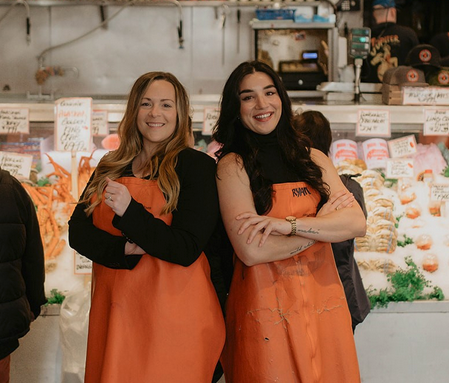In case you missed it, in part one of this influencer marketing series we talked about how this strategy is so effective, it will have you buying peanut butter through Instagram DMs - for real. If anyone questioned the reality of that purchase we are here to tell you that it is 100% real. We know that for a fact because we clicked ‘Buy Now’. Hey, hi, we’re the ones you should be selling to, we’re the target audience for influencer marketing strategies, and we know how to make it happen.
In our last piece, The Benefits of Influencer Marketing for Seafood, we provided an overview of the influencer marketing landscape, the benefits of influencer marketing, and the massive opportunity that the seafood industry has in front of it with influencers.
In this piece, we’re getting into the mechanics of influencer marketing with a step-by-step tutorial on how seafood businesses can actually start to engage with influencers strategically to help grow both their online presence and their bottom line.
Before we get started on the “How To” we want to set one very important boundary: Influencers are professionals and this is their job. It’s not always reasonable to expect content in exchange for free products. Working with Influencers is a marketing strategy and, like any other service, you should expect to pay for it based upon the deliverables you are requesting and the amount of value you stand to gain.
In the case of sending products without a contract, for example PR boxes, companies should not expect anything in exchange. PR boxes should be your way of saying “hey, we’re here and we want you to give us a try, no strings attached.” Be respectful of the influencers you wish to work with and understand that if they choose to post about your products, that’s a bonus, but if they don’t, you cannot fault them for it.
Now, if you want to hire an influencer to create content about your brand, here’s how you can do it.
How to get started in influencer marketing:
● Define Your Goals: What do you aim to achieve through influencer marketing? Are you looking to increase brand awareness, drive sales, promote new products, or build credibility? Being crystal clear on these goals will guide your influencer selection and campaign strategies.
● Identify Your Target Audience: Define your target audience's demographics, interests, and preferences. Are they health conscious? Outdoor lovers? Busy parents? This understanding will help you choose influencers whose followers align with your target market.
● Find Relevant Influencers: Research influencers who specialize in food, seafood, sustainability, or related niches. Think about follower count, engagement rate, content quality, and audience demographics when selecting influencers you’d like to work with
● Build Relationships: Remember, influencers are people too! You’re not speaking to a corporate marketing agency, so while professionalism remains paramount as in any working relationship, you can be a bit more human about it. After all, a high value currency in the social media marketing world is relatability. Reach out to selected influencers with personalized messages, either through a DM (direct message) or via their preferred method for inquiries, which is usually stated in their bios, and start a conversation! Express genuine interest in their content and discuss potential collaboration ideas that align with your brand values and goals.
● Collaborate on Content: How do you want your product or brand to be seen? Working with influencers to create engaging and authentic content means sharing ideas of how you think your product shows best, and then allowing the influencer to combine that with their awareness of what their audience likes to see. This could include recipe videos, cooking demos, product reviews, sustainability initiatives, or behind-the-scenes glimpses of your seafood operations. Be careful not to micro-manage the content creation and let the influencer put their unique spin on it.
● Set Clear Expectations: Everyone likes to know where they stand in a deal, and influencers are no different. Clearly outline deliverables, timelines, compensation, and brand guidelines to ensure that everyone is aligned on expectations to avoid misunderstandings.
● Leverage Multiple Platforms: Different demographics tend to gravitate towards different social media platforms. TikTok is hot with gen Z, while older millennials tend to lean towards Instagram and Pinterest. Utilizing various social media platforms can help you reach different audience segments, and practiced influencers know how to tailor their content to suit each platform and maximize your brands visibility
● Track and Measure Performance: Remember that first point about crystal clear goals? This is where the numbers tell the story of how those goals are being reached. Monitor key performance metrics such as engagement rates, reach, conversions, and ROI. Using tracking tools and analytics to evaluate the effectiveness of your influencer campaigns gives you the ability to adapt in real time and make data-driven adjustments as needed.
● Encourage Engagement with Followers: A huge part of the allure of influencers is that they don’t feel like an impossible star on a screen being paid to sell whatever’s in their hand. They’re relatable peers and can even come to feel like friends. The trust factor is built when influencers engage with their followers by responding to comments, answering questions, and encouraging user-generated content. Engaging with the audience helps transfer that trust and credibility to your brand.
● Nurture Long-Term Partnerships: Things going strong? Consider developing long-term relationships with successful influencers who align well with your brand values, are proving great to work with, and consistently deliver positive results. Long-term partnerships can yield ongoing benefits, build on audience familiarity, and strengthen brand loyalty over time.
Influencer marketing can be a very effective way to reach new audiences in an authentic and organic way, especially the ones that have been historically difficult for seafood stakeholders to reach.
Not to overstate it, but this is seafood’s key to tapping into these markets.
If you’re still feeling stuck with influencer marketing, firstly, don’t stress. We get it. This is mostly uncharted territory for seafood companies and can be a daunting space to enter.
And we’re here to help you through it. If you’re looking for support in engaging with influencers, reach out to InnaSea Media.







